
From Dolphins Fan: “Re: Accretive Health. I finally had a chance to read the Accretive SEC filings. Ascension Health is their largest client as well as a major (11% stake) investor. I wonder how Wall Street reacts to a situation where the client supplying the largest share of company revenues is also someone who stands to gain big from the IPO? Take that major investor/client out of the revenue mix and this is really a pretty small company.”
From Chanice Kobolowski: “Re: Epic registry. Hospitals that need Patient Registry functionality should look into Phytel. Epic has a great deal of this functionality embedded in their integrated applications, but the true registry functionality is not present, in my opinion. Several Epic clients use Phytel for this need.”
From Kid Rockette: “Re: vendor installations. Is there a free source that says which hospitals are running which clinical information systems?” None that I know of, but I will defer in case anyone has a source. CHIME used to have something, I think, but I don’t know how current or pervasive it was.
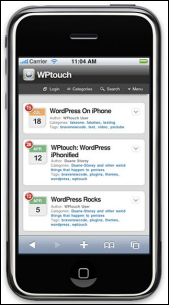
From Goin’ Mobile: “Re: blog format. I often read your blog on my iPhone. Have you ever thought of running a WordPress plug-in like WPtouch iPhone Theme? It nicely formats the blog for mobile devices.” I have WordPress Mobile Edition running, although I need to upgrade it. I looked at the iPhone theme but it scared me since it seems to want to take over the master theme, which would displease the 99% of readers who are reading from a PC screen. Maybe I’ll get some expert to figure it out for me since I like the idea.
From Carol Queen: “Re: Flash ads. We are a sponsor and I vote against the flash ads. Let them use a link to tell their story. Flash is annoying and I actually ignore ANY Flash ads, anywhere.” A reader sent over an recent article whose finds were that most Flash ads are ignored, but text-based ads surprisingly aren’t (since they seem to offer solutions to whatever the reader is looking for). The bottom line was that simple ads work best on Web sites. Some sites ban animated ads, but I’m uncomfortable telling marketing pros which ads will probably work best even though I probably know pretty well from experience and personal preference.
From IT_Nurse: “Re: unions. In the September issue of Registered Nurse (a California nurse’s union magazine), there’s a 20-page tirade about the evils of HIT, including CDSS, CPOE, EBM, EHR, HIE, HIT, RCM, RFID, RTLW among others. Their conclusion: the whole industry is just a management ploy designed to replace RNs and should be resisted at every opportunity.” It’s really hard to take a professional group’s union seriously when they are so quick to lash out at everything that’s employer-related, all while using what they claim are the best interests of patients as a hammer to beat management over the head. They probably have a good point every now and then, but as a former manager in a violently unionized hospital, everything I saw first-hand was highly negative. You haven’t lived until you’ve seen striking union lab techs and nurses destroying hospital lab equipment, blocking ambulances and doctors from getting to the ED, and cursing and taunting the family members of patients trying to check on their loved ones. And, the union’s blocking of my attempt to upgrade some of my para-professional staff so I could pay them more because it “would cause resentment” — meaning my people were paying mandatory dues to an organization who refused to let me increase their wages. Or, like this current example, where the Steelworkers Union (which represents non-professional hospital workers!) is suing a hospital for banning smoking on campus.
Analytics vendor Quantros licenses University of Michigan-developed technology that creates Patient Safety Indicators from discharge diagnosis codes for follow-up.
What’s driving me up the wall lately: crappy online slide shows that magazines put together for some reason. I get a teaser e-mail for “Top 16 Declining Tech Salaries for 2010” (you know who you are, eWEEK), click the link, and only then find out it’s the cheesiest, slowest, dumbest slide show in the world. Not only do I not need to see stupid clip art with what little story is there, I don’t need to click and click and click (of course, they love that since they are probably selling ads based on clicks). I will not waste 10 minutes watching a slideshow that contains content I could have read in literally 20 seconds had they not been so cutesy about it.

The Army creates the Joint Telemedicine Network for a relatively cheap $10 million, allowing X-rays to be transmitted among its far-flung facilities into the AHLTA EHR. Before it was implemented, soldiers being evacuated from the field often beat their X-rays to Landstuhl AFB, making trauma treatment within the Golden Hour impossible. Kudos to those named in the excellent Nextgov article as key players: now-retired LTC Alfred Hamilton, CMIO; LTC Nanette Patton, deputy CIO; Salvatore Granata, project manager; and MAJ Dan Bridon, director of command, control, and communications for the 30th Theater Medical Command at Bagram AFB, Afghanistan.
I’ve mentioned before that HIStalk’s sponsors, in most cases, aren’t just running ads — they are fans of what we do who read it and want to support it. Submitted for your approval: Quality IT Partners, a new sponsor who did a reverse sponsorship in putting the HIStalk intentionally ironic smokin’ doc on their page along with some nice words.
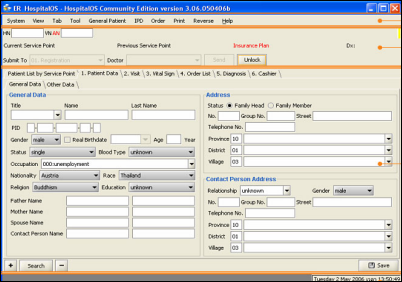
Thailand-based Hospital OS, an award-winning open source hospital systems vendor, is giving hospitals analyzed information back from their data: best practices, clinical guidelines, alerts, and an epidemic alarm system to track disease outbreaks back to their source.
Listening: Supergrass, British alternative that’s been around since the early 1990s. Reader recommended as something I’d like, which it is.

This brilliant MSNBC article speaks volumes: New York medical practices are using separate entrances and providing different levels of service for patients with and without insurance. Example: Lenox Hill Radiology takes insurance, requires 15 days to get an appointment, takes more than a week to give results by mail, and always has 20-30 patients crammed into its waiting room. New York Private Medical Imaging has a four-chair waiting room for its cash-only patients, gives appointments in two days, hands out plush robes instead of flimsy gowns, and doctors read the images immediately and visit personally with the patient immediately after. The separate entrances lead to the same techs, rooms, and equipment because it’s the same company with the same radiologists reading the images. Most interesting is that patients on the boutique side are warned not to tell the insurance patients about “their door” and employees sign a written policy agreeing to do the same.
The EHR of Mater Health Services in Australia holds the records of 1.4 million patients, connects 95 separate clinical systems, and handles 100,000 messages per day, integrated using InterSystems Ensemble.
Michael Nauman is named VP/CIO of Children’s Hospital and Health System (WI). Old news that I missed until now.
I’ve been really busy lately, so I’ve got a backlog of interviews and reader articles ready to go. Soon it will be time for the HISsies voting, additional ideas for the HIMSS event (shaping up nicely, I should add), and maybe some new stuff. It’s been a really good and fun year, even though I occasionally wish I’d done something more than work all the time. The thanks I’m giving, in no particular order: Mrs. HIStalk for putting up with me, Inga for making what we do fun, those in the military for the sacrifices they make, and the people who are in healthcare and healthcare IT for patients and not a bloated paycheck. And of course, every HIStalk reader, sponsor, guest author, and interviewee who makes me anxious to run to the computer as soon as I get home from work every day and stay there for way too long.
The plastics convention people aren’t just taking their show to Orlando after decades in Chicago, they’re running a Crain’s Chicago Business investigative piece on the authority that runs McCormick Place: (a) the CEO got the job after raising money for Rod Blagojevich and lots of its bigwigs are connected to the Daley political machine, including a former bartender given a $130K HR job because of connections; (b) despite extortionate charges, it loses a ton of money; (c) it taxes citizens directly, collecting over $100 million a year and borrowing $2.5 billion using the state’s credit line; (d) McCormick Place West was a 2007 boondoggle that will fall short of paying itself by $500 million; (e) they’re laying off 500 people despite having added more senior managers; and (f) companies that contributed to political campaigns got contracts to service the facilities despite their markedly higher bids. If you are shocked by any of this, you obviously don’t know much about Chicago (I like to think President Obama is clean, but the fact that he worked his way up there makes me wonder since honest Chicago politicians are unheard of).
GE gets into the Web-based teleradiology business in India, planning to provide software and hosting to emerging markets.
LogMeIn’s remote support solution wins a healthcare IT award from a company that helps vendor sell stuff (“innovative sales and marketing solutions”). I’m sure there is no connection, especially since “hundreds of IT executives” voted for the winners “after previewing and learning about new technologies and services in private boardroom appointments”.
Nuance announces Q4 results: revenue up 3.9%, EPS $0.02 vs. $0.09, beating expectations.
Strange: Apple says users void their warranty if they smoke around their Macs since the second-hand smoke is a biohazard for its techs. And, the Turkey Genome Sequencing Project gets a $900K grant to find ways to improve the immune system of turkeys, with the timing of the announcement being fortuitous since I assumed the purpose isn’t to enhance the quality of life for Thanksgiving-doomed turkeys, but rather to keep the cost low and the profit high in selling their carcasses.
What the authors of a Christian Science Monitor editorial hate about the Senate’s healthcare bill: mandatory insurance, HIEs, EDI, analysis of data for effectiveness research, and unprotected PHI.
Odd lawsuit: a woman has surgery without fentanyl when a drug-addicted nurse steals it, replacing it with water. She’s suing the nurse and the hospital.
E-mail me.
HERtalk by Inga
Sarasota Memorial Health Systems recently entered its 50 millionth order into Eclipsys Sunrise. I was having trouble grasping how many 50 million is, so I did some simple math. If you input 27,397 orders a day, it would take five years to enter 50 million orders.

Cascade Healthcare Community (OR) leverages Accenx ExchangeT to integrate its clinical information system to distribute lab results to community clinics and regional hospitals.
The Rochester RHIO says that over 100,000 patients have opted to share their health information with their participating doctors. About 500 physicians are participating in the RHIO, which uses Axolotl’s Elysium Patient Index to manage the patient data.
Iowa’s Medicaid program is the first recipient of a federal matching funds program for EHR. The $1.6 million grant from the CMS will allow Iowa to begin planning the activities necessary to implement EHRs.
The prolific folks at KLAS release a new report examining revenue cycle consultants and whether the returns are worth the investment. Perot Systems was the top performer in the extended business office category.
Meanwhile, KLAS says it’s making its performance evaluations shorter, based on feedback from providers and vendors. KLAS will also begin grouping questions on software into four main categories. The goal of the changes is to eliminate redundancy and focus on questions that best differentiate vendors.
The current poll to the right points out that EMRs have not been shown to improve quality or cost and asks who’s to blame. I think the ever-brilliant Mr. H left out at least one blame category (it’s probably due to all those long hours he has been working). I don’t think the issue is necessarily software nor providers needing to use the software better. Instead, perhaps we should look at implementers (who may be vendors, consultants, or internal staff) who fail to diagnose flaws in work processes and thus promote inefficient workflows. Of course, someone could still say the software doesn’t lend itself to efficient workflow (so blame the vendor) or that providers won’t change (blame hospital management).

Mr. H and I are facing some new competition in the blogosphere with the launch of HHS’s Health IT Buzz. David Blumenthal says he will use the forum to report on the progress of healthcare technology, health information exchange, and the meaningful use of EHR, plus “create an open dialogue among members of the health IT community.” Kind of like what we do here but probably without Mr. H’s the good / the bad / and the ugly approach. Likely no music or shoe recommendations either.
Speaking of shoes, a special thank you to all our wonderful sponsors who support HIStalk and HIStalk Practice. Without your support, I would be resigned to last season’s shoe fashions, which would certainly make Clinton Kelly cringe.
Zynx Healthcare partners with the Healthcare Solutions division of Keane to integrate Zynx decision support solutions with Keane’s OptimumTM EHR.
The House passes a $10 billion loan program to help doctors and small medical practices purchase EMR and other HIT systems. The bill would allow loans of up to $350,000 per physician and $2.5 million for group practices. The bill has now moved on to the Senate.

Dr. Blumenthal took some time out from blogging to announce HHS’s plans to make $80 million in grants available to help develop and strengthen the HIT workforce. Seventy million dollars will be available for community college training programs and $10 million will used to develop educational materials to support the programs.
The nation’s most stressful job: surgeon. Also making the Top Eight list are general practice physician, physician assistant, and newspaper reporter (no mention of bloggers, though). The least stressful jobs include computer systems analyst and software engineer (i guess when you are creating software you can’t get too stressed about missing release dates or producing buggy software).
In yet another new report, KLAS looks at the anesthesia information (AIS) market, which is deemed “small and immature.” Of the 100 organizations interviewed, almost all claimed holes in functionality for reporting and integration. However, all products had generally high marks for ease of use. The highest rated products were GE Centricity Perioperative Anesthesia, Philips CompuRecord, Picis Anesthesia Manager, and Draeger Medical Innovian Anesthesia.
Health Industry Insights releases two separate reports, each assessing the offerings in the ambulatory EMR space. The reports looks at the one-to-20 provider market, as well as the 20+ provider space. Mr. H wasn’t willing to pony up the few thousand bucks required to look at the report details, so we are hoping readers will fill us in. Sage Healthcare reports they did “great, landing firmly in the upper right quadrant on both reports.” eClinicalWorks also says they did “quite well.”
The MGMA sends a letter to David Blumenthal, noting concerns that an inappropriate definition of meaningful use and an ineffective administration of ARRA stimulus funds could result in a failed implementation of ARRA, needless squandering of resources, and significant disruption of the health system. MGMA offered several specific recommendations, including instituting a pilot test prior to the start of the program to ensure that the process of demonstrating meaningful use is achievable and practical. The letter also encourages the National Coordinator’s office to monitor the EHR marketplace for cost-effective and efficient products and to ensure fair business practices. To William Jessee and staff: well-done. MGMA is voicing valid concerns that highlight the many gaps in ARRA legislation, and offers logical recommendations. We absolutely need the meaningful use requirements to be achievable and applicable. And, why not do some testing in advance to make sure that HHS, vendors and providers all agree what meaningful use looks like. I am not sure how necessary it is to have the government provide vendor oversight; I mean, if a vendor doesn’t have a product that works, won’t market forces address that? Still, MGMA did a good job addressing what are likely major concerns of its members.
I am truly thankful for many things. Near the top of the list are HIStalk/HIStalk Practice and of course Mr. H and our readers. Some days I have to pinch myself to make sure it’s all real, that I really do get to spend my days reading and writing about the fun world of HIT, that people send me notes saying they like my stuff, and that I even make a little bit of money doing it. I’m also thankful for yummy food, good wine, college football, and days off. Happy Thanksgiving!

Holiday greetings or football bets here.












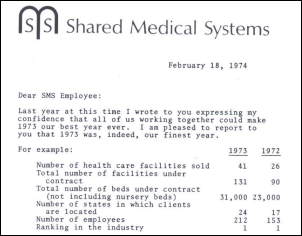


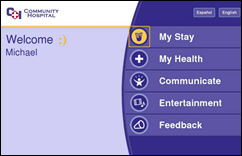
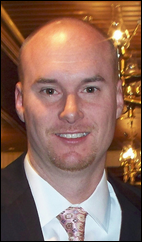



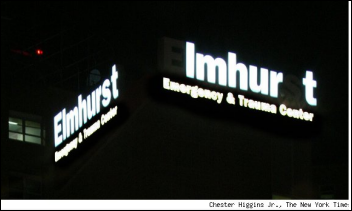











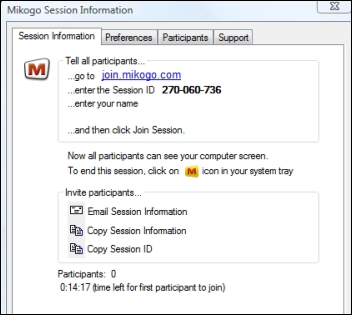

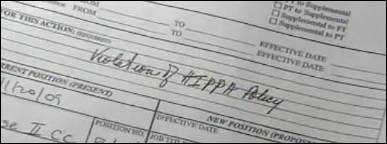










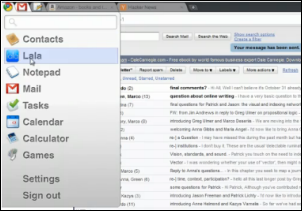
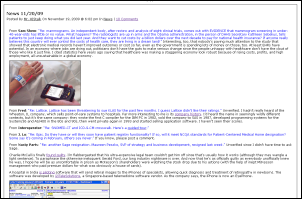

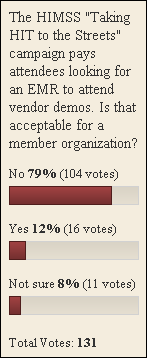

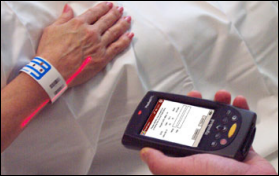
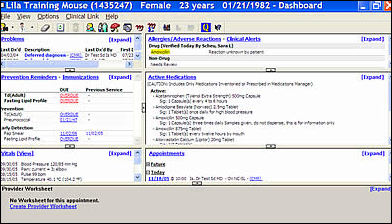






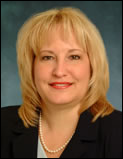
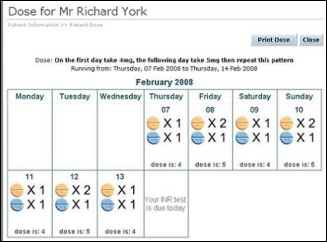









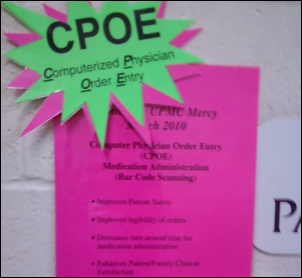


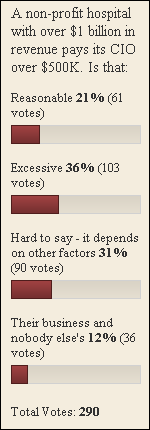





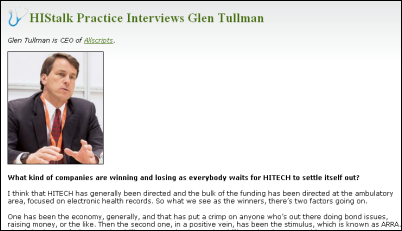



















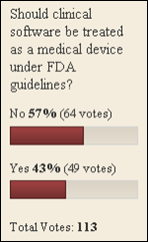
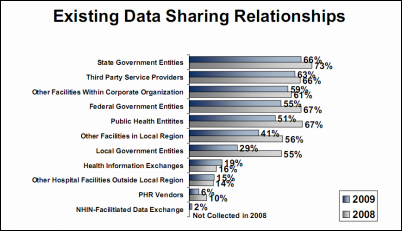
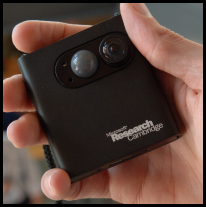
























































































The primary point of using the Cloud is using operating expenses vs limited capital ones and avoiding having to update…